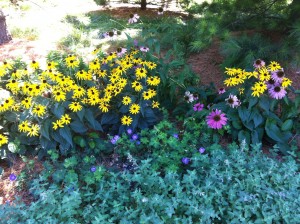 Here’s an energy-saving tip–and pollution-saving tip–that some people don’t always consider because it’s been so ingrained in our culture that we must have vast lawns: get rid of some of it! Portions of lawns can be converted to many different things: native grasses, native wild flowers, rock gardens, rain gardens, or vegetable beds. All of these options are still beautiful, require less maintenance, help ground water absorption, and attract more birds and butterflies. Seriously: do you really need all of that lawn to run around on?
Here’s an energy-saving tip–and pollution-saving tip–that some people don’t always consider because it’s been so ingrained in our culture that we must have vast lawns: get rid of some of it! Portions of lawns can be converted to many different things: native grasses, native wild flowers, rock gardens, rain gardens, or vegetable beds. All of these options are still beautiful, require less maintenance, help ground water absorption, and attract more birds and butterflies. Seriously: do you really need all of that lawn to run around on?
How does this save energy? Primarily it has to do with the amount of energy it takes to mow lawns — usually a weekly endeavor, and usually done with a gasoline-powered mower. (Of course, if you want to keep that lawn, there are other options: mowing with an electric mower or a push mower is definitely a step in the right direction!)
The other benefit is reduced pollution — both in terms of reduced gas emissions from less mowing, reduced ground water pollution from less lawn fertilizer, and reduced noise pollution, which the neighbors would appreciate. Combustion-engine lawn mowers emit disproportionately large amounts of junk that contribute to smog; the EPA estimates that lawn mowers contribute as much as 5% of the nation’s air pollution. What’s wrong with smog? It contributes to asthma and other respiratory illnesses, among other things (like turning the sky a shade of brown, rather than blue)!
As spring is nearing and the snow is melting, it’s a great time to consider the outdoors as part of an overall energy reduction strategy.
